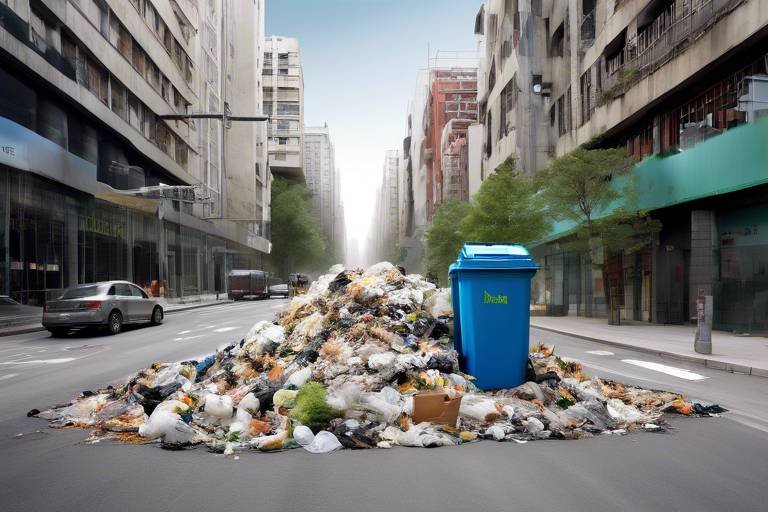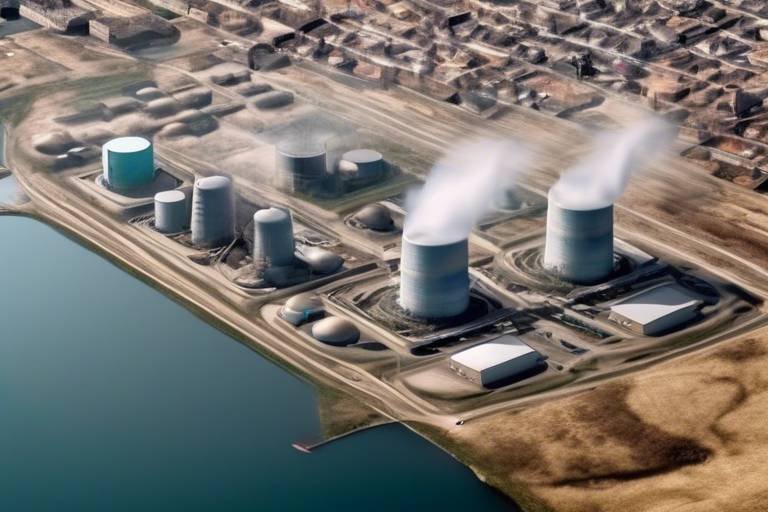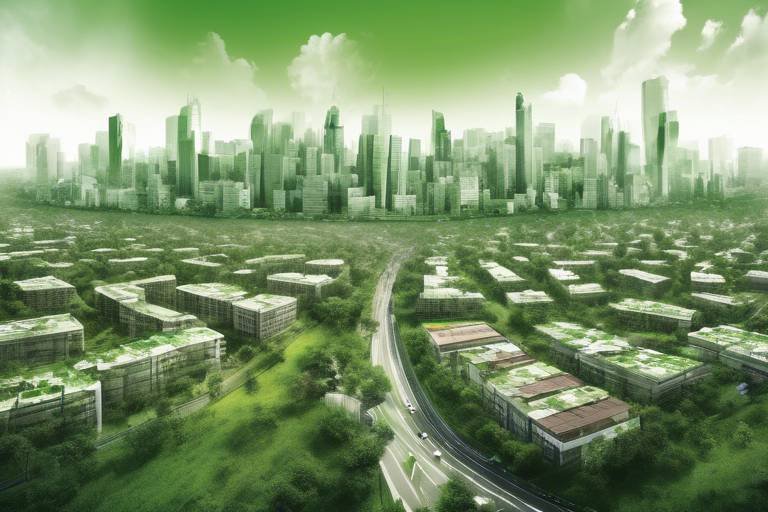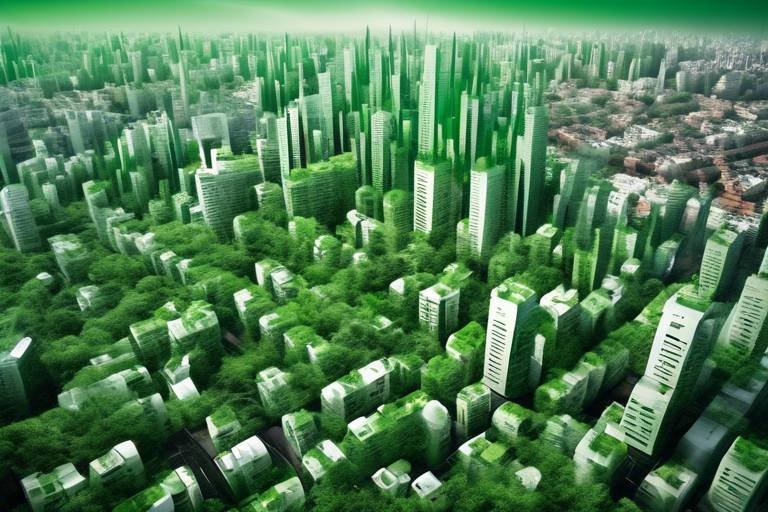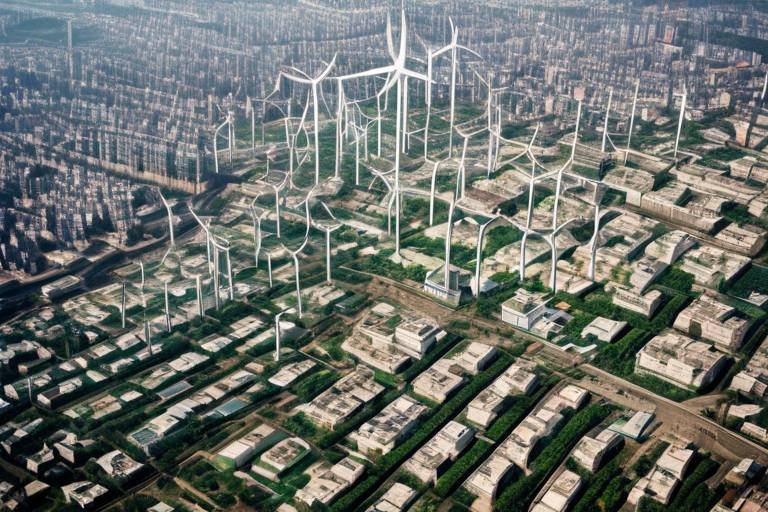Can Waste-to-Energy Solve the Trash Problem in Cities?
As urban populations continue to swell, the challenge of managing waste becomes increasingly daunting. Cities around the globe are grappling with overflowing landfills, rising disposal costs, and the pressing need for sustainable energy solutions. Enter waste-to-energy (WTE) technologies, a beacon of hope in the fight against urban waste management issues. But can these technologies truly solve the trash problem? In this article, we will delve into the potential of WTE systems, exploring their benefits, challenges, and real-world applications that showcase their effectiveness in reducing landfill use while generating much-needed energy.
Waste-to-energy technologies are designed to convert non-recyclable waste materials into usable energy. This transformation occurs through various methods, each with its unique processes and benefits. The most common WTE methods include:
- Incineration: This process involves burning waste at high temperatures, reducing its volume and generating heat, which can be converted into electricity.
- Anaerobic Digestion: In this method, microorganisms break down organic waste in the absence of oxygen, producing biogas that can be used for heating or electricity.
- Gasification: This technique converts organic or fossil-based materials into carbon monoxide, hydrogen, and carbon dioxide at high temperatures, producing syngas that can be used for energy.
These processes play a crucial role in waste management by not only reducing the volume of waste but also providing alternative energy sources that can power our cities sustainably.
One of the most compelling arguments for adopting WTE technologies is their environmental benefits. By converting waste into energy, WTE can significantly reduce landfill waste, lower greenhouse gas emissions, and conserve natural resources. Let's break down these advantages:
- Reducing Landfill Dependency: WTE facilities can divert significant amounts of waste from landfills, thereby prolonging their lifespan. This is particularly important as many urban areas struggle with limited landfill space.
- Lowering Greenhouse Gas Emissions: By reducing the amount of organic waste in landfills, WTE technologies help mitigate methane emissions, a potent greenhouse gas that contributes to climate change.
- Conserving Natural Resources: WTE processes can recover valuable materials and energy from waste, reducing the need for virgin resources and promoting a circular economy.
One of the significant advantages of WTE is its ability to minimize reliance on landfills. As cities grow, the pressure on waste disposal systems intensifies, leading to overflowing landfills that pose environmental risks. WTE facilities can effectively divert waste from these sites, allowing for more sustainable waste management practices. By prolonging the lifespan of existing landfills, WTE not only reduces environmental impact but also buys time for cities to develop more comprehensive waste management strategies.
As urban populations swell, the availability of landfill space becomes a critical concern. Many cities are running out of room to dispose of waste, leading to increased transportation costs and environmental degradation. WTE technologies offer a viable solution by significantly reducing the volume of waste that needs to be landfilled. For instance, incineration can reduce waste volume by up to 90%, which can drastically alleviate the pressure on landfill capacities.
Landfills are notorious for being significant sources of methane emissions, which are harmful to both the environment and public health. WTE technologies can help mitigate these emissions by diverting organic waste away from landfills and converting it into energy. This not only improves air quality but also contributes to a healthier urban environment. Imagine a city where waste is not just discarded but transformed into energy, powering homes and businesses while simultaneously protecting our planet.
WTE not only manages waste but also generates energy, providing a dual benefit that is hard to overlook. Various forms of energy can be produced through WTE processes, including electricity, heat, and biofuels. This energy can be harnessed to power cities sustainably, reducing reliance on fossil fuels. The potential for WTE to contribute to a greener energy mix is immense, making it a vital component of urban sustainability strategies.
While implementing WTE technologies requires significant investment, the long-term economic benefits can be substantial. Not only can WTE projects create jobs and stimulate local economies, but they can also lead to savings in waste management costs. A thorough evaluation of the economic implications is essential for cities considering WTE as a solution to their waste problems.
The establishment of WTE facilities can lead to job creation across various sectors, from construction to operations. This not only boosts local employment but also fosters community engagement in sustainability efforts. Jobs in the WTE sector can range from engineers and technicians to administrative roles, providing diverse opportunities for local residents.
Conducting a cost-benefit analysis is crucial for assessing the viability of WTE projects. This analysis should consider initial investments, operational costs, and potential long-term savings associated with reduced landfill use and energy generation. By weighing these factors, cities can make informed decisions about whether to adopt WTE technologies as part of their waste management strategies.
1. What is waste-to-energy?
Waste-to-energy (WTE) is a process that converts non-recyclable waste materials into usable energy, such as electricity or heat, through various technologies like incineration, anaerobic digestion, and gasification.
2. How does waste-to-energy help the environment?
WTE helps the environment by reducing landfill waste, lowering greenhouse gas emissions, and conserving natural resources, promoting a more sustainable waste management approach.
3. What are the economic benefits of waste-to-energy?
WTE can create jobs, stimulate local economies, and lead to long-term savings in waste management costs, making it a financially viable option for cities.
4. Can waste-to-energy completely eliminate the need for landfills?
While WTE significantly reduces the volume of waste sent to landfills, it may not completely eliminate the need for landfills. However, it can prolong their lifespan and reduce environmental impacts.

Understanding Waste-to-Energy Technologies
This article explores the potential of waste-to-energy technologies in addressing urban waste management challenges, examining benefits, challenges, and case studies that highlight its effectiveness in reducing landfill use and generating energy.
Waste-to-energy (WTE) technologies are innovative solutions that transform non-recyclable waste materials into usable energy, and they play a crucial role in modern waste management strategies. Imagine taking what we usually consider trash and turning it into something valuable—like electricity or heat! This process not only helps to manage waste but also contributes to energy production, making it a win-win situation for cities grappling with waste disposal issues.
There are several methods involved in WTE technologies, each with its own unique processes and benefits. The most common methods include:
- Incineration: This method involves burning waste at high temperatures, which reduces its volume significantly while generating heat that can be converted into electricity. Incineration can handle a wide variety of waste types, including municipal solid waste, industrial waste, and medical waste.
- Anaerobic Digestion: In this process, organic materials are broken down by microorganisms in the absence of oxygen, producing biogas that can be used for heating or electricity generation. This method is particularly effective for food waste and agricultural residues.
- Gasification: Gasification converts organic or fossil-based materials into carbon monoxide, hydrogen, and carbon dioxide at high temperatures, producing a synthetic gas that can be used to generate electricity or as a fuel for vehicles.
Each of these methods offers distinct advantages and can be tailored to fit the specific needs of a city. For instance, incineration is often favored for its ability to handle large volumes of waste and its efficiency in energy production, while anaerobic digestion is celebrated for its effectiveness in managing organic waste and reducing greenhouse gas emissions.
Furthermore, WTE technologies can be integrated into existing waste management systems, providing a comprehensive approach to urban waste challenges. By utilizing these technologies, cities can not only reduce the amount of waste sent to landfills but also generate clean energy, thus contributing to sustainability goals.
However, it's important to recognize that the implementation of WTE technologies is not without challenges. Public perception, regulatory hurdles, and initial capital investment can pose significant barriers to the establishment of WTE facilities. Yet, as cities continue to grow and the waste crisis deepens, the potential of WTE technologies to transform waste into energy becomes increasingly appealing.
In summary, understanding waste-to-energy technologies is essential for cities looking to tackle their waste management issues head-on. By converting waste into energy, cities can not only reduce landfill dependency but also contribute to a more sustainable urban environment. As we explore further in this article, the environmental and economic benefits of WTE technologies make them a compelling option for modern waste management.
Here are some common questions regarding waste-to-energy technologies:
- What types of waste can be processed through WTE? WTE technologies can process a variety of waste types, including municipal solid waste, industrial waste, and organic materials.
- How does WTE impact greenhouse gas emissions? WTE can significantly reduce greenhouse gas emissions by diverting waste from landfills, where it would otherwise decompose and produce methane.
- Are WTE facilities safe for the environment? When properly managed and regulated, WTE facilities can operate safely, minimizing harmful emissions and contributing to cleaner energy production.

Environmental Benefits of Waste-to-Energy
When we think about waste management, the conversation often revolves around the mountains of trash piling up in landfills, right? But what if I told you that waste-to-energy (WTE) technologies could not only tackle this issue but also provide a host of environmental benefits? It's like hitting two birds with one stone! WTE processes convert non-recyclable waste into usable energy, which significantly reduces landfill waste while simultaneously generating power. This dual benefit is crucial for urban sustainability, especially as cities grapple with increasing waste production and limited landfill space.
One of the most significant advantages of WTE is its potential to reduce landfill dependency. By diverting waste from landfills, WTE facilities can extend the lifespan of these sites, which are already facing capacity issues due to growing urban populations. Imagine a city where waste is transformed into energy instead of just sitting in a landfill, slowly decomposing and releasing harmful gases. This not only helps in managing waste effectively but also minimizes the environmental footprint of our trash.
Speaking of environmental footprints, let's tackle the issue of emissions. Landfills are notorious for their methane emissions, a potent greenhouse gas that contributes to climate change. WTE technologies can help mitigate these emissions significantly. By converting waste through processes like anaerobic digestion or incineration, WTE facilities reduce the amount of waste that would otherwise produce methane in a landfill. In fact, studies have shown that WTE can cut landfill emissions by up to 80%, which is a huge win for air quality and public health.
Moreover, WTE contributes to resource conservation. By generating energy from waste, we are effectively reclaiming resources that would otherwise be lost. This process not only reduces the need for fossil fuels but also lessens the environmental impact associated with extracting and processing new materials. It’s like recycling on steroids! Instead of burying our waste, we can turn it into something valuable, fostering a more sustainable circular economy.
To further illustrate the environmental benefits of WTE, let’s take a look at the following table that summarizes key advantages:
| Benefit | Description |
|---|---|
| Landfill Diversion | Reduces the volume of waste sent to landfills, prolonging their lifespan. |
| Emission Reduction | Significantly lowers methane and other harmful emissions associated with landfills. |
| Energy Generation | Produces renewable energy from waste, reducing reliance on fossil fuels. |
| Resource Recovery | Reclaims valuable materials and energy from waste, promoting a circular economy. |
In conclusion, the environmental benefits of waste-to-energy technologies are multifaceted and impactful. By addressing landfill dependency, reducing harmful emissions, and promoting resource conservation, WTE presents a viable solution to the pressing waste management challenges faced by urban areas. It's time we embrace this innovative approach and step towards a cleaner, greener future.
- What is waste-to-energy? Waste-to-energy refers to processes that convert non-recyclable waste materials into usable energy, such as electricity or heat.
- How does WTE reduce landfill waste? WTE facilities process waste to generate energy, which diverts waste from landfills and reduces the overall volume of trash.
- Are there any emissions associated with WTE? While WTE does produce emissions, it significantly reduces methane emissions compared to traditional landfilling methods.
- What types of energy can be generated from WTE? WTE can produce various forms of energy, including electricity, heat, and biofuels, contributing to a more sustainable energy mix.

Reducing Landfill Dependency
One of the most pressing issues in urban waste management is the overwhelming dependence on landfills. As cities expand and populations grow, the amount of waste produced increases exponentially. This leads to a scenario where landfills are filling up faster than we can manage them, resulting in a race against time to find sustainable solutions. Waste-to-energy (WTE) technologies present a compelling opportunity to tackle this problem head-on. By converting non-recyclable waste into energy, WTE facilities can significantly reduce the volume of waste that ends up in landfills.
Imagine a bustling city where trash is not just a nuisance but a valuable resource. WTE technologies allow us to think differently about waste. Instead of viewing it as a burden, we can see it as a potential source of energy. This transformation is not just theoretical; it has practical implications that can change the landscape of urban waste management. For instance, WTE facilities can process vast amounts of waste that would otherwise occupy precious landfill space, thereby extending the lifespan of existing landfills and delaying the need for new sites.
To illustrate the impact of WTE on landfill dependency, consider the following statistics:
| City | Waste Diverted from Landfill (tons/year) | Energy Generated (MWh/year) |
|---|---|---|
| City A | 200,000 | 50,000 |
| City B | 150,000 | 40,000 |
| City C | 300,000 | 80,000 |
This table shows how different cities have successfully diverted significant amounts of waste from landfills while generating substantial energy. The figures speak volumes about the potential of WTE technologies to reshape our approach to waste management.
Moreover, WTE facilities not only help reduce landfill dependency but also contribute to a cleaner environment. By minimizing the amount of waste sent to landfills, we can mitigate the negative impacts associated with them, such as soil and water contamination. Furthermore, WTE technologies significantly lower the volume of methane gas released into the atmosphere—a potent greenhouse gas that exacerbates climate change. In essence, by investing in WTE, cities can take a giant leap towards sustainability.
However, the transition to WTE is not without its challenges. Public perception and concerns about emissions from WTE facilities can be hurdles that need to be addressed. It is essential for cities to engage with their communities, providing transparent information about the benefits and safety of WTE technologies. By fostering a dialogue, cities can build trust and support for these innovative waste management solutions.
In conclusion, reducing landfill dependency through waste-to-energy technologies is not just a dream; it is a necessary step towards sustainable urban living. As we continue to innovate and find better ways to manage our waste, the potential for WTE to transform our cities is immense. We have the opportunity to turn our trash into treasure, paving the way for a cleaner, greener future.
- What is waste-to-energy? Waste-to-energy is a process that converts non-recyclable waste materials into usable energy, typically in the form of electricity or heat.
- How does waste-to-energy help reduce landfill use? By converting waste into energy, WTE facilities divert significant amounts of waste from landfills, thereby extending their lifespan and reducing the need for new landfill sites.
- Are there any environmental concerns associated with WTE? While WTE technologies can reduce landfill emissions, it's important to monitor and manage emissions from the facilities themselves to ensure they meet environmental standards.
- Can waste-to-energy facilities generate jobs? Yes, the establishment and operation of WTE facilities can create numerous jobs in construction, engineering, and facility management.

Landfill Space and Capacity Issues
The rapid growth of urban populations has brought about a pressing challenge: the diminishing availability of landfill space. As cities expand, the amount of waste generated increases exponentially, leading to a situation where existing landfills are quickly reaching their capacity. This phenomenon is not just a local concern; it is a global issue affecting metropolitan areas around the world. In many regions, the quest for suitable landfill sites has become a contentious battle, often leading to community opposition and environmental concerns. So, what happens when we run out of space to dispose of our waste?
Many cities are facing the reality of having to transport waste further distances, which not only increases operational costs but also contributes to greater greenhouse gas emissions due to transportation. Imagine a city where garbage trucks are constantly on the move, burning fuel and polluting the air, all because there is no local place to dump the waste. This scenario illustrates the urgent need for sustainable waste management solutions.
Furthermore, the environmental impact of overflowing landfills is significant. As waste decomposes, it produces harmful leachate and gases, including methane, which can seep into groundwater and contribute to climate change. This is where waste-to-energy (WTE) technologies come into play. By diverting waste from landfills to WTE facilities, cities can effectively extend the lifespan of existing landfills while simultaneously generating energy. The table below highlights the stark contrast between traditional landfill methods and WTE technologies in terms of space utilization and environmental impact:
| Aspect | Landfill Method | Waste-to-Energy Method |
|---|---|---|
| Land Use | Requires vast areas for waste disposal | Uses smaller footprint for energy generation |
| Waste Diversion | Minimal diversion from landfill | Significant diversion from landfill |
| Emissions | High methane emissions | Lower emissions, energy recovery |
| Resource Recovery | None | Energy and materials recovery |
By adopting WTE technologies, urban planners can tackle the landfill space crisis head-on. Not only do these technologies provide a practical solution to waste management, but they also foster a circular economy where waste is viewed as a resource rather than a burden. This shift in perspective is crucial for sustainable urban development. As cities continue to grow, the integration of WTE facilities can help ensure that they remain livable and environmentally friendly.
- What is waste-to-energy technology? Waste-to-energy technology refers to processes that convert non-recyclable waste materials into usable energy, primarily through incineration, anaerobic digestion, or gasification.
- How does waste-to-energy help with landfill issues? Waste-to-energy helps by reducing the volume of waste sent to landfills, thereby extending their lifespan and reducing environmental impacts.
- Are there any environmental concerns associated with waste-to-energy? While waste-to-energy technologies do produce emissions, they are generally lower than those from landfills, and advancements continue to improve their efficiency and reduce their environmental footprint.
- Can waste-to-energy facilities generate jobs? Yes, the establishment of waste-to-energy facilities can create numerous jobs in construction, operation, and maintenance, contributing to local economies.

Mitigating Landfill Emissions
Landfills are notorious for being significant contributors to greenhouse gas emissions, particularly methane, which is a potent climate change agent. As waste decomposes anaerobically (without oxygen) in these sites, it releases methane into the atmosphere, which is over 25 times more effective at trapping heat than carbon dioxide over a 100-year period. This alarming fact raises the question: how can we tackle this pressing issue? Enter waste-to-energy (WTE) technologies.
WTE offers a two-fold solution: it not only diverts waste from landfills but also captures and utilizes the energy produced during waste processing. By converting waste into energy through methods like incineration and anaerobic digestion, we can significantly reduce the volume of waste that ends up in landfills. For instance, incineration can reduce the waste mass by up to 90%, thereby minimizing the need for landfill space and subsequently decreasing methane emissions.
Moreover, WTE facilities are equipped with advanced emission control technologies that help mitigate the release of harmful gases. These systems can capture methane and other volatile organic compounds (VOCs), preventing them from entering the atmosphere. This not only contributes to improved air quality but also enhances public health outcomes for communities near landfill sites.
To illustrate the impact of WTE on emissions, consider the following table that compares emissions from traditional landfills versus WTE facilities:
| Emission Type | Landfills | WTE Facilities |
|---|---|---|
| Methane (CH4) | High | Low |
| Carbon Dioxide (CO2) | Moderate | Moderate |
| Volatile Organic Compounds (VOCs) | High | Controlled |
As cities grapple with the challenges of waste management, the role of WTE in mitigating landfill emissions becomes increasingly crucial. By adopting these technologies, urban areas can not only reduce their carbon footprint but also foster a healthier environment for their residents. It's a win-win situation: less waste in landfills and cleaner air to breathe.
In conclusion, the integration of waste-to-energy technologies into urban waste management strategies is a powerful tool in the fight against landfill emissions. As we continue to innovate and improve these systems, we pave the way for a more sustainable future where waste is not just a problem but a valuable resource.

Energy Generation Potential
When we think about waste, the first image that often comes to mind is a mountain of garbage, just sitting there, taking up space and contributing to pollution. But what if I told you that this very waste could be transformed into a valuable resource? Waste-to-energy (WTE) technologies are not just about managing waste; they also hold remarkable potential for generating energy. Imagine turning trash into electricity, heat, or even fuel—sounds like something out of a sci-fi movie, right?
WTE processes primarily include incineration, anaerobic digestion, and gasification. Each of these methods converts waste into energy in unique ways:
- Incineration: This method burns waste at high temperatures, converting it into ash, flue gas, and heat. The heat generated can be used to produce steam, which drives turbines to generate electricity.
- Anaerobic Digestion: In this process, organic waste is broken down by bacteria in the absence of oxygen, producing biogas, which can be used as a renewable energy source.
- Gasification: This technique converts organic or fossil-based materials into carbon monoxide, hydrogen, and carbon dioxide at high temperatures, which can then be used to generate electricity or as a feedstock for further chemical processes.
The energy generated from these processes can significantly contribute to a city's power supply. For instance, a well-designed WTE facility can produce enough electricity to power thousands of homes, effectively turning a waste problem into a sustainable energy solution. It's like finding gold in your backyard—what was once seen as a nuisance can become an asset.
Moreover, the energy produced through WTE is not just limited to electricity. The heat generated from incineration can be harnessed for district heating systems, providing warmth to homes and businesses in nearby areas. This dual benefit of waste management and energy generation is a win-win scenario for urban sustainability.
However, it’s essential to recognize that while WTE technologies offer significant energy generation potential, their implementation must be carefully managed. Factors such as emissions control, public acceptance, and economic feasibility play crucial roles in the success of WTE projects. When cities invest in WTE, they’re not just investing in waste management; they’re investing in a cleaner, more sustainable future.
1. What types of waste can be used in waste-to-energy processes?
WTE technologies can utilize a variety of non-recyclable waste materials, including municipal solid waste, industrial waste, and agricultural residues. However, materials that can be recycled should be separated beforehand.
2. Is waste-to-energy environmentally friendly?
While WTE technologies can help reduce landfill waste and generate energy, they must be implemented with stringent emissions controls to minimize pollutants. Overall, they can be part of a broader strategy for sustainable waste management.
3. How much energy can be generated from waste?
The amount of energy produced can vary widely depending on the waste composition and the technology used. On average, WTE facilities can generate between 500 to 600 kWh of electricity per ton of waste processed.
4. What are the economic benefits of waste-to-energy?
WTE facilities can create jobs, reduce waste disposal costs, and provide a stable source of renewable energy. While initial investments may be high, the long-term savings and job creation can outweigh the costs.

Economic Considerations of Waste-to-Energy
Implementing waste-to-energy (WTE) technologies is a significant investment, but it can yield substantial returns for cities grappling with waste management challenges. The financial implications of adopting WTE are multifaceted, encompassing initial setup costs, operational expenses, and potential long-term savings. While the upfront costs can be daunting, the long-term benefits often outweigh these initial investments.
First and foremost, WTE facilities can contribute to the local economy by creating jobs. From the construction phase to ongoing operations, the establishment of a WTE facility can generate a variety of employment opportunities. For instance, jobs can range from engineers and technicians to waste management specialists and administrative roles. This influx of job creation can stimulate local economies and provide stable employment for residents.
To illustrate the potential job creation, consider the following breakdown:
| Job Type | Estimated Positions Created |
|---|---|
| Construction Workers | 50-100 |
| Operations Staff | 20-40 |
| Maintenance Technicians | 10-20 |
| Administrative Roles | 5-10 |
Moreover, the operational costs of WTE facilities can be offset by the energy they produce. The energy generated from waste can be harnessed for electricity, heating, or even fuel, which can help to reduce energy costs for municipalities. In many cases, cities can sell excess energy back to the grid, creating an additional revenue stream. This not only helps in recovering some of the initial investments but also contributes to a more sustainable energy model.
However, it is essential to conduct a thorough cost-benefit analysis when considering WTE projects. This analysis should include not just the financial aspects but also the environmental and social impacts. Here are some key factors to consider:
- Initial investment costs: This includes construction, technology acquisition, and permitting.
- Operational costs: Ongoing expenses related to staffing, maintenance, and energy production.
- Potential revenue: Income generated from energy sales and reduced landfill tipping fees.
- Long-term savings: Decreased waste management costs and environmental benefits.
In conclusion, while the economic considerations of waste-to-energy technologies may appear complex, the potential for job creation, energy generation, and long-term savings makes it a compelling option for urban waste management. By viewing WTE not just as a waste solution but as an economic opportunity, cities can pave the way for a more sustainable and prosperous future.
1. What is waste-to-energy?
Waste-to-energy is a process that converts non-recyclable waste materials into usable energy, typically in the form of electricity, heat, or fuel.
2. How does waste-to-energy benefit the environment?
WTE reduces the amount of waste sent to landfills, lowers greenhouse gas emissions, and conserves natural resources by generating energy from waste.
3. Are WTE facilities expensive to build?
Yes, the initial investment for WTE facilities can be high, but they can provide long-term savings and economic benefits through job creation and energy production.
4. Can WTE facilities produce enough energy to power a city?
While WTE facilities can generate significant amounts of energy, their output varies based on the technology used and the volume of waste processed. However, they can contribute to a city's overall energy needs.
5. What types of waste can be used in WTE processes?
WTE technologies typically utilize non-recyclable waste, including municipal solid waste, industrial waste, and certain agricultural residues.

Job Creation in the WTE Sector
When we think about waste-to-energy (WTE) technologies, the first thing that often comes to mind is their ability to manage waste effectively. However, there’s another critical aspect that deserves our attention: job creation. The establishment of WTE facilities can lead to a significant influx of employment opportunities across various sectors. Imagine a bustling plant where engineers, technicians, and operational staff work hand in hand to convert waste into energy. It’s not just about reducing landfill waste; it’s about creating a thriving ecosystem of jobs that can uplift local economies.
These facilities require a diverse workforce, including roles in construction, operations, maintenance, and administration. For instance, during the construction phase of a WTE plant, numerous jobs are generated, ranging from skilled laborers to project managers. Once the facility is operational, ongoing employment opportunities arise in areas such as:
- Engineering and Technical Support: Engineers and technicians are essential for maintaining and optimizing the technology used in WTE processes.
- Operations Management: Facility managers and supervisors oversee daily operations, ensuring efficiency and safety.
- Environmental Compliance: Specialists are needed to monitor emissions and ensure that the facility adheres to environmental regulations.
- Administrative Roles: Support staff in human resources, finance, and logistics help keep operations running smoothly.
Moreover, the ripple effect of job creation extends beyond the facility itself. Local businesses can also benefit from the economic activity generated by WTE projects. For example, suppliers of materials and services needed for construction and ongoing operations can see increased demand, leading to further job creation in the community. It’s a win-win situation where not only is waste being transformed into energy, but people are also gaining employment, thereby improving their quality of life.
Additionally, WTE facilities often invest in training and development programs for their employees, ensuring that the workforce is skilled and well-prepared for the future. This investment in human capital not only benefits the employees but also enhances the overall performance of the facility. The more skilled the workforce, the more efficient the operations, leading to better energy production and waste management outcomes.
In conclusion, the job creation potential in the WTE sector is significant. As cities grapple with the challenges of waste management and energy production, WTE technologies offer a dual benefit: they help solve pressing environmental issues while simultaneously creating valuable employment opportunities. By embracing WTE, cities can pave the way for a sustainable future, where both the planet and its people thrive.
Q: What types of jobs are available in the WTE sector?
A: Job opportunities in the WTE sector include engineering, operations management, environmental compliance, and administrative roles, among others.
Q: How does WTE contribute to local economies?
A: WTE facilities create jobs directly and indirectly, stimulating local businesses and increasing economic activity in the community.
Q: Are jobs in the WTE sector sustainable?
A: Yes, jobs in the WTE sector are generally sustainable as they are tied to ongoing operations and the increasing need for effective waste management and energy production.

Cost-Benefit Analysis of WTE
When it comes to implementing waste-to-energy (WTE) technologies, one of the most crucial steps is conducting a cost-benefit analysis. This analysis helps stakeholders understand the financial implications of investing in WTE facilities, weighing both the costs associated with setup and operation against the potential benefits. At first glance, the initial investment might seem daunting, but a deeper dive reveals a landscape of economic advantages that can significantly outweigh these costs over time.
To break it down, let’s consider the various components that come into play in a typical WTE project:
| Cost Factors | Estimated Amount |
|---|---|
| Initial Investment (Construction) | $20 million - $100 million |
| Operational Costs (Annual) | $5 million - $15 million |
| Maintenance Costs | $1 million - $3 million |
These figures can vary widely based on the technology used, the scale of the facility, and local regulations. However, the benefits of WTE can also be quantified:
- Energy Production: WTE facilities can generate substantial amounts of energy, which can be sold back to the grid or used to power local operations, significantly offsetting energy costs.
- Reduced Landfill Costs: By diverting waste from landfills, cities can save on landfill fees and extend the lifespan of existing landfill sites.
- Job Creation: The construction and operation of WTE facilities can create numerous jobs, contributing to local economies.
Moreover, the long-term savings associated with WTE technologies are compelling. By transforming waste into energy, cities can reduce their reliance on fossil fuels, potentially leading to lower energy prices in the long run. Additionally, WTE can significantly lower greenhouse gas emissions, which can translate into savings on environmental compliance and health-related costs.
However, it’s essential to remain aware of the potential challenges and criticisms associated with WTE. Some argue that the initial costs and environmental impacts of certain WTE technologies, such as incineration, can be significant. Therefore, it’s vital for cities to consider their specific circumstances, including the type of waste generated and local energy needs, before proceeding with WTE projects.
In conclusion, while the cost-benefit analysis of waste-to-energy technologies may present a complex picture, the potential for economic growth, environmental sustainability, and energy independence makes it a worthwhile consideration for urban areas facing waste management challenges. As cities continue to grow, finding innovative solutions like WTE could be the key to a cleaner, more sustainable future.
What is waste-to-energy (WTE)?
WTE refers to technologies that convert non-recyclable waste materials into usable energy through processes like incineration, anaerobic digestion, and gasification.
What are the main benefits of WTE?
The primary benefits include reducing landfill waste, generating renewable energy, lowering greenhouse gas emissions, and creating jobs.
Is WTE environmentally friendly?
While WTE can reduce landfill emissions and generate energy, some processes, particularly incineration, can produce pollutants. It's essential to implement advanced technologies to minimize these impacts.
How does WTE impact local economies?
WTE can stimulate local economies by creating jobs, reducing waste management costs, and generating revenue through energy sales.
Frequently Asked Questions
-
What is waste-to-energy (WTE) technology?
Waste-to-energy (WTE) technology refers to processes that convert non-recyclable waste materials into usable energy. This can include methods like incineration, anaerobic digestion, and gasification. Essentially, WTE transforms trash into power, tackling both waste management and energy generation!
-
How does WTE reduce landfill waste?
WTE facilities can significantly decrease the amount of waste sent to landfills by converting it into energy. This not only prolongs the lifespan of existing landfills but also mitigates the environmental issues associated with waste accumulation. It’s like turning a problem into a solution!
-
What are the environmental benefits of WTE?
WTE technologies offer several environmental advantages, such as reducing landfill waste, lowering greenhouse gas emissions, and conserving natural resources. By diverting waste from landfills, WTE helps improve air quality and supports urban sustainability.
-
Can WTE help with greenhouse gas emissions?
Absolutely! WTE technologies can help mitigate harmful emissions from landfills, especially methane, which is a potent greenhouse gas. By converting waste into energy, WTE reduces the overall carbon footprint associated with waste disposal.
-
What types of energy can be generated from WTE?
WTE processes can produce various forms of energy, including electricity, heat, and even biofuels. This energy can be used to power homes, businesses, and even entire cities, making WTE a powerful ally in the quest for sustainable energy solutions.
-
What are the economic implications of implementing WTE?
While establishing WTE facilities requires significant investment, they can lead to job creation and stimulate local economies. The construction and operation of these facilities open up various employment opportunities, contributing to economic growth.
-
How does WTE impact job creation?
WTE projects can generate jobs across multiple sectors, from construction and engineering to operations and maintenance. This job creation not only supports the local workforce but also helps foster a community committed to sustainable practices.
-
Is a cost-benefit analysis necessary for WTE projects?
Yes! Conducting a cost-benefit analysis is crucial to assess the financial viability of WTE projects. It helps stakeholders understand initial investment costs, operational expenses, and potential long-term savings, ensuring informed decision-making.

